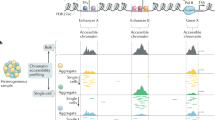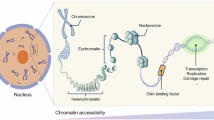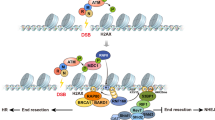Abstract
EUKARYOTIC DNA is complexed with proteins which influence its conformation, stability and function1,2. Attempts to correlate the chemical and biological properties of chromatin have focused on the coverage of DNA by chromosomal proteins3–8. As much as 50% of the DNA in chromatin is accessible to precipitants (such as basic dyes or polylysine)3–6 or to limiting nucleolytic digestion3,4,6–8, suggesting a model of segmental DNA accessibility in chromatin resembling a frayed telephone wire. Digestion extensively alters chromatin structure, however, and the results of experiments involving precipitation or digestion may be influenced by processes associated with the aggregation phenomena serving as experimental endpoints. We have used an alternative approach to characterise DNA accessibility in chromatin using the transfer of electronic excitation energy between pairs of fluorescent dyes bound to chromatin at low ratios of dye to phosphate. The results suggest that at least one-third of the DNA in chromatin retains a high affinity for basic dyes. The exclusion of dyes or other molecules9 from portions of chromatin may, however, depend on the conformation of chromatin as well as on the protein–DNA stoichiometry.
This is a preview of subscription content, access via your institution
Access options
Subscribe to this journal
Receive 51 print issues and online access
$199.00 per year
only $3.90 per issue
Buy this article
- Purchase on SpringerLink
- Instant access to full article PDF
Prices may be subject to local taxes which are calculated during checkout
Similar content being viewed by others
References
Simpson, R. T., Adv. Enzymol., 38, 41–108 (1973).
Bonner, J., Dahmus, M. E., Fambrough, D., Huang, R. C. C., Marushige, K., and Tuan, D. Y. H., Science, 159, 47–56 (1968).
Clark, R. J., and Felsenfeld, G., Nature new Biol., 229. 101–106 (1971).
Clark, R. J., and Felsenfeld, G., Nature new Biol., 240, 226–232 (1972).
Itzhaki, R. M., Biochem. J., 122, 583–592 (1971).
Simpson, R. J., and Polacow, F., Biochem. biophys. Res. Commun., 55, 1078–1084 (1973).
Itzhaki, R. M., Biochem. J., 125, 221–224 (1971).
Clark, R. J., and Felsenfeld, G., Biochemistry, 13, 3622–3628 (1974).
Simpson, R. T., Proc. natn. Acad. Sci. U.S.A., 71, 2740–2743 (1974).
Forster, T., in Modern quantum chemistry, (edit. by Sinanoglu, O.), 93–137 (Academic, New York, 1965).
Stryer, L., Science, 162, 526–533 (1968).
Waring, J. J., J. molec. Biol., 13, 269–282 (1965).
Le Pecq, J. P., and Paoletti, C., J. molec. Biol., 27, 87–106 (1967).
Lerman, L., Proc. natn. Acad. Sci. U.S.A., 49, 94–102 (1963).
Latt, S. A., Brodie, S., and Munroe, S. H., Chromosoma, 49, 17–40 (1974).
Zubay, G., and Doty, P., J. molec. Biol., 1, 1–20 (1959).
Latt, S., Proc. natn. Acad. Sci. U.S.A. 70, 3395–3399 (1973).
Gursky, G. V., Zasedatelev, A. S., and Strelzov, S. A., Studia Biophys., 40, 105–108 (1973).
Angerer, L. M., Georghious, S., and Moudrianakis, E. N., Biochemistry, 13, 1075–1082 (1974).
Bartley, J. A., and Chalkley, R. J., Biol. Chem., 247, 3647–3655 (1972).
Simpson, R. T., Biochemistry, 11, 2003–2008 (1972).
Author information
Authors and Affiliations
Rights and permissions
About this article
Cite this article
BRODIE, S., GIRON, J. & LATT, S. Estimation of accessibility of DNA in chromatin from fluorescence measurements of electronic excitation energy transfer. Nature 253, 470–471 (1975). https://doi.org/10.1038/253470a0
Received:
Revised:
Issue date:
DOI: https://doi.org/10.1038/253470a0
This article is cited by
-
A simple method for the DNA content assay of culture maintained pancreatic islets of Langerhans
Journal of Endocrinological Investigation (1991)
-
Accurate determination of DNA content in single cell nuclei stained with Hoechst 33258 fluorochrome at high salt concentration
Histochemistry (1987)
-
Fluorescence label studies of the phase transitions of T7
Biophysics of Structure and Mechanism (1983)
-
Cytochemical studies of metaphase chromosomes by flow cytometry
Chromosoma (1980)



